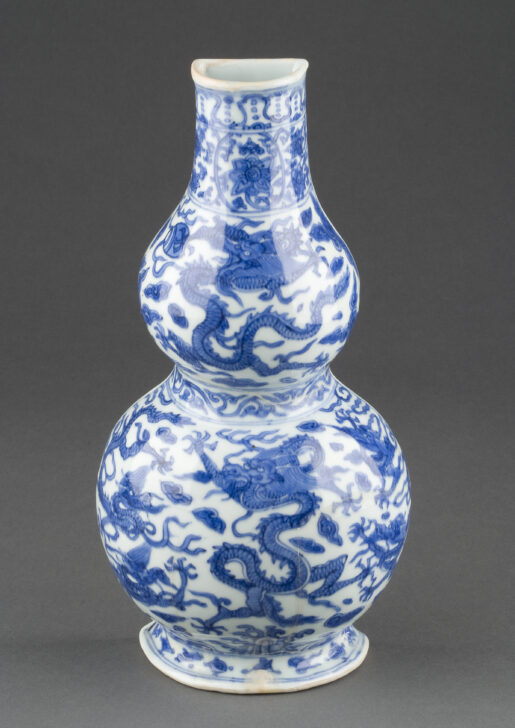Double-Gourd Wall Vase
Chinese

Description
Gallery Rotation Summer 2013
5. Double-gourd wall vase with phoenix design
China, Jiangxi province, Jingdezhen, Ming dynasty, 1368–1644,Wanli mark and period
1573–1620
Porcelain with underglaze cobalt blue and overglaze enamel decoration
Gift of Marian Doering in memory of Paul M. Doering, 1979/2.12
6. Double-gourd wall vase with dragon design
China, Jiangxi province, Jingdezhen, Ming dynasty, 1368–1644,Wanli mark and period
1573–1620
Porcelain with underglaze cobalt blue decoration
The Margaret Watson Parker Art Collection Fund, 1986/2.13
The Chinese dragon, a benevolent animal that exhales clouds and fire, symbolizes the emperor and heaven. The Yin counterpart to the Yang dragon is the phoenix, which presides over the southern area of the heavens and represents the sun, warmth, and summer. The phoenix is the emblem of the empress. The double gourd or calabash is a symbol of the unity between heaven and earth. Both of these vases are believed to have been used in imperial sedan chairs and were made at the Jingdezhen imperial kiln in southern China, which produced porcelain for the exclusive use of the Ming and, later, Qing court.
Subject Matter:
A qinghua (清华) blue and white bi ping (壁瓶) double gourd wall vase of the Wanli period (1573-1620) of the Ming Dynasty (1368-1644).
The Chinese dragon, a benevolent animal that exhales clouds and fire, symbolizes the emperor and heaven. The yin counterpart to the yang dragon is the phoenix, which presides over the southern area of the heavens and represents the sun, warmth, and summer. The phoenix is the emblem of the empress. The double gourd or calabash is a symbol of the unity between heaven and earth. Both of these vases are believed to have been used in imperial sedan chairs and were made at the Jingdezhen imperial kiln in southern China, which produced porcelain for the exclusive use of the Ming and later, Qing court.
The discovery of kaolin clay at Jingdezhen, Jiangxi led to the establishment of official kilns during the Yuan dynasty (1279-1368), and the production of pure, white, hard paste porcelain and porcelain decorated with underglaze blue. During the 13th century of the Yuan dynasty, with the establishment of Pax Mongolia, blue and white porcelains were exported to Europe and the Middle East, as tribute gifts and for the overseas export market. This continued through the Ming dynasty where porcelain was used domestically by all classes of society. A vast array of forms and designs were made to appeal to a large and diverse overseas, as well as, domestic market.
One of the most popular forms of decoration was underglaze cobalt blue. During the Yuan dynasty, the principal source of cobalt came from Persia, in the Ming, however, local sources were found. The domestic cobalt, high in manganese and iron, resulted in a deep blue color with dark specks that has become known as a “heap and piled” effect, a hallmark of Ming qinghua (blue and white) wares, that was imitated in the later Qing dynasty.
Physical Description:
A porcelain bottle vase of double gourd form on a flared footring with a tall, narrow neck; the reverse side is flat with a slot for hanging. The vase is outlined in underglaze blue and has a six-character Wanli mark in a plaque. The front is decorated with underglaze blue five-clawed dragons among clouds—five dragons on the lower bulb and one on the upper—confined between floral borders. The vase is covered in a clear glaze.
Usage Rights:
If you are interested in using an image for a publication, please visit https://umma.umich.edu/request-image/ for more information and to fill out the online Image Rights and Reproductions Request Form.